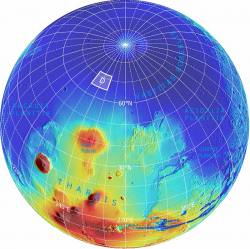All systems look good for Saturday’s launch of NASA Phoenix Mars Lander from Florida’s Cape Canaveral. If everything goes as planned, the latest visitor to the Red Planet will blast off as early as August 4th at 0926 UTC (5:26 am EDT) atop a Boeing Delta II rocket. A second launch windows is also possible later on in the day.
The Delta II rocket will carry the Phoenix into orbit, and then give it a push into its flight trajectory about 90 minutes later. This will begin the 8 month journey to reach the Red Planet; the spacecraft will eventually cover a distance of 679 million kilometres, arriving at Mars on May 25, 2008.
When it reaches Mars, the spacecraft will enter the planet’s atmosphere directly, aiming for a landing spot at 68.35 degrees north latitude – the equivalent of northern Alaska back on Earth. It will reach the surface using a combination of parachutes and retro-rockets.
Once it gets to the ground, the Mars Phoenix Lander is stuck; it’s a lander, not a rover. It’ll use a collection of scientific instruments, including a long digging arm to investigate its surroundings. Its will be to probe down into the ground beneath the surface, searching for water. The lander’s instruments are designed to search for evidence of periodic melting of the ice. This would help scientists know if this region represents a habitable environment for microbes.
Good luck Phoenix.
Original Source:NASA JPL News Release

